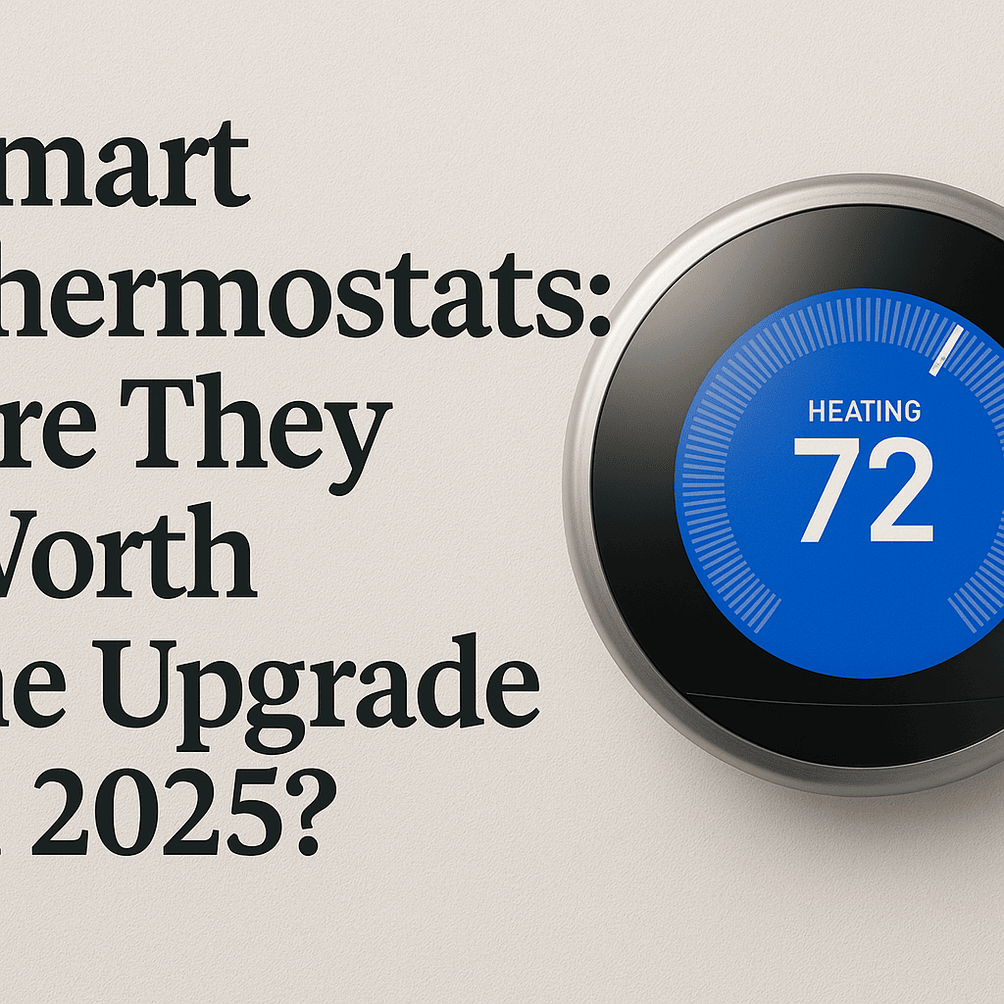Understanding Smart Thermostats in 2025
Smart thermostats have become an essential part of modern HVAC systems, especially as homes evolve into smart ecosystems. In 2025, these intelligent devices are more advanced than ever—offering AI-driven learning, remote access, energy optimization, and multi-zone control features that were once considered premium luxuries.
Top Features of 2025 Smart Thermostats
1. AI-Powered Learning Algorithms
Smart thermostats in 2025 are not just programmable—they learn your behavior. These devices adapt based on your preferences, usage patterns, and local weather. Within weeks of installation, a smart thermostat can autonomously adjust your home’s temperature settings for maximum comfort and efficiency.
2. Geofencing & Occupancy Detection
With built-in geofencing, smart thermostats can detect when you’re home or away using your smartphone’s location. Occupancy sensors take it further by adjusting the temperature based on real-time presence, helping eliminate unnecessary heating or cooling when the space is empty.
3. Integration with Smart Home Systems
Compatibility in 2025 has reached new heights. Smart thermostats now integrate seamlessly with Amazon Alexa, Google Home, Apple HomeKit, and even IFTTT. They also pair with other smart devices like window sensors, smart blinds, and even EV chargers to ensure optimized energy use across your home.
4. Voice Control & App Access
The ability to control your HVAC system via voice commands or from a mobile app is standard in 2025. Whether you’re lying in bed or halfway around the world, adjusting your thermostat is just a tap or voice command away.
5. Real-Time Energy Monitoring
Modern smart thermostats provide detailed energy usage reports. Users can track heating/cooling consumption in real-time, compare it to previous months, and receive actionable tips to reduce energy bills.
Compatibility With Existing HVAC Systems
One of the major concerns homeowners have is: Will a smart thermostat work with my current setup? In 2025, manufacturers have significantly improved compatibility. Most leading models support:
- 24V HVAC systems (standard in North America)
- Gas, oil, electric, and dual-fuel systems
- Multi-stage systems
- Zoned HVAC systems
For homes without a C-wire (common wire), many smart thermostats now come with power extenders or alternative wiring solutions to ensure easy installation without needing an electrician.
Cost of Smart Thermostats in 2025
Initial Investment
Prices range from $120 to $400, depending on the brand and feature set. Premium models with features like multiple room sensors, humidity control, and solar panel integration command higher prices.
Installation Costs
DIY installation is possible for most models, but professional setup may cost an additional $100 to $250. Some utility companies offer rebates or free installation as part of energy-efficiency programs.
Long-Term Savings and ROI
Energy Savings
According to updated data from the U.S. Department of Energy in 2025, smart thermostats can reduce energy bills by 10% to 23% annually. For a household spending $2,000 a year on heating and cooling, this translates to savings of $200–$460 annually.
Reduced HVAC Wear & Tear
By running your HVAC system only when needed and minimizing short cycling, smart thermostats extend the lifespan of your equipment—leading to lower maintenance and replacement costs over time.
Rebates & Incentives
Many provinces, states, and cities in 2025 offer cash-back rebates, tax incentives, or utility discounts for smart thermostat installations, accelerating the return on investment.
Leading Smart Thermostat Brands in 2025
1. Google Nest Learning Thermostat (5th Gen)
- Strengths: Exceptional AI learning, slick interface, robust app support
- New in 2025: Solar integration and compatibility with EVs
- Best for: Homeowners seeking smart automation and long-term value
2. Ecobee Smart Thermostat Premium
- Strengths: Built-in Alexa, air quality monitor, multi-room sensor support
- New in 2025: AI-powered occupancy forecasting
- Best for: Multi-level homes with zoning needs
- Strengths: HVAC contractor-friendly, reliable performance
- New in 2025: Expanded compatibility with ductless systems
- Best for: Traditional HVAC systems and commercial setups
Smart Thermostats for Multi-Zone Control
One of the biggest selling points in 2025 is the ability to manage different temperature zones. Whether you own a two-story home or a split HVAC system, smart thermostats like Ecobee or Nest can pair with multiple sensors, ensuring each room maintains optimal comfort.
Advanced zoning allows you to heat or cool only occupied areas, drastically improving efficiency and ensuring individual comfort for different rooms or family members.
Potential Downsides to Consider
1. Privacy Concerns
Smart thermostats collect data like location, routines, and energy usage. While most brands have strong privacy policies, users must carefully review permissions and ensure network security.
2. Internet Dependency
If your Wi-Fi goes down, some features like app control and remote access may become temporarily unavailable. However, most thermostats retain basic functionality offline.
3. Learning Curve
Although easy to use, there’s an initial learning curve with settings, integrations, and features. Users who aren’t tech-savvy might prefer a model with simpler manual modes.
Who Should Upgrade in 2025?
Ideal for:
- Homeowners with rising energy bills
- Smart home enthusiasts
- Multi-level households looking for zoned control
- Owners of vacation or rental properties
- Environment-conscious families aiming for lower carbon footprints
Not Necessary for:
- Homes with non-compatible HVAC systems (e.g., some radiant systems)
- Renters unable to modify property wiring
- Those who are rarely away and already use basic programmable thermostats effectively
Final Verdict: Are Smart Thermostats Worth It in 2025?
Absolutely yes—for most homeowners, the combination of comfort, energy savings, automation, and control makes smart thermostats a smart investment in 2025. The upfront cost is quickly offset by lower utility bills, and with enhanced AI features, better compatibility, and robust smart integrations, the devices are more valuable than ever before.
For maximum savings and comfort, choose a thermostat that suits your system, lifestyle, and goals. And if you’re not sure, consult an HVAC professional to confirm compatibility and maximize efficiency.


